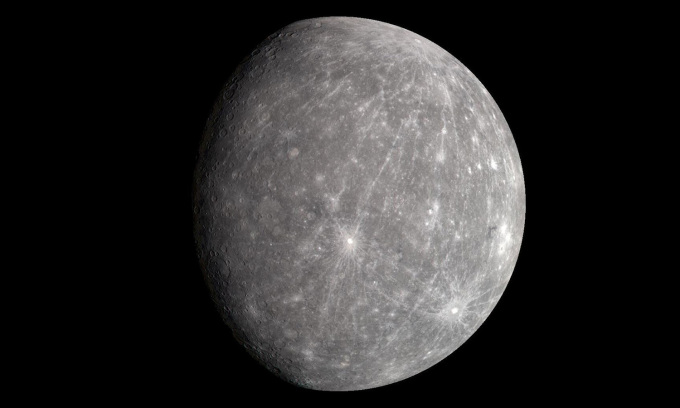Earth has distinct seasons, primarily due to its axial tilt, and winters are colder, but this isn't the case for all planets in the solar system.

Mercury has a year that lasts only 88 days and short seasons. Photo: NASA/Wikipedia
Mercury
With a year lasting only 88 Earth days, all seasons on Mercury are short. However, the lack of atmosphere (not to mention oceans) to distribute heat evenly leads to fluctuating temperatures, making the environment extremely harsh.
On Earth, seasons occur primarily due to the Earth's axis tilt of about 23.5 degrees, causing one hemisphere to receive more sunlight than the other over a given period. But this is not true for Mercury, a planet whose axis is tilted at only 2 degrees.
Mercury's distance from the Sun varies greatly, from 46 million km to 69 million km. Therefore, at its closest point in orbit, Mercury receives twice as much radiation as at its farthest point. Mercury's true winter occurs when the planet is farthest from the Sun. At that time, midday temperatures at the equator are more than 150 degrees Celsius lower than when the planet is at its closest point.
However, the greatest temperature variations are not seasonal. Mercury's day is 59 Earth days long, so there is plenty of time for things to heat up or cool down. Even in winter, it's very hot in the middle of the day (around 270°C) at the equator, but cold at night, with temperatures potentially dropping to -173°C at the equator, and even colder near the poles.
Venus
Venus is very hot; even in the middle of winter and at midnight, the surface temperature does not drop below 438 degrees Celsius.
Mars
Winter on Mars is more similar to Earth's than on any other planet. A year on the red planet is almost twice as long as an Earth year, and winter lasts about four months. The average temperature on Mars is also much colder. When winter occurs in one hemisphere, the ice cap there grows by capturing about a quarter of the atmosphere (mostly CO2) as dry ice, which then shrinks again in the spring.
On Earth, the effects of the seasons are regulated by the ocean. The ocean also acts as a huge reservoir of heat. In the past, this may have been true for Mars as well, albeit to a different degree. But now, Mars no longer has oceans, so the temperature range is much wider. Mars can be very cold in winter, with temperatures recorded as low as -153 degrees Celsius, and possibly even lower because many landing sites and rovers cease operation in winter due to lack of sunlight to recharge their batteries. This means scientists have yet to record the coldest temperatures ever recorded.

The ice cap on Mars may expand in winter. Photo: NASA/JPL/USGS
Jupiter
Jupiter doesn't have distinct seasons. Its axis is tilted only 3 degrees, not much more than Mercury's. Jupiter's orbit is also nearly circular, so the amount of sunlight it receives is not significantly different. Winter there is similar to any other time of year.
Saturn
Saturn's axis is tilted slightly more than Earth's, at 26.7 degrees. At times not near the equinox, one hemisphere of Saturn receives slightly more sunlight than the other. However, this doesn't significantly alter the temperature. Even during hot summers, Saturn is too far from the Sun to warm up considerably. The planet's thick atmosphere helps redistribute much of the heat. In the upper atmosphere, temperatures can drop to -191 degrees Celsius in winter.
Uranus
Uranus has an axis tilted at 97 degrees. This causes significant differences in sunlight during the seasons, with one pole almost directly facing the sun in summer and almost completely facing away from it in winter. Therefore, winters are very long and dark. Winters are also very cold, but mainly because the entire planet is perpetually cold, colder than Neptune despite being closer to the sun.
Neptune
At 28.3 degrees, Neptune's axis is tilted more than Earth's. Its orbit is also very circular, so, similar to Earth, the seasons are determined by which hemisphere receives more sunlight. However, the planet receives only about 0.1% of the amount of sunlight that Earth receives. Unlike Uranus, Neptune receives considerable warmth from its core, but this warmth doesn't change with the seasons, so winter cold isn't significantly different from summer cold.
Thu Thao (According to IFL Science )
Source link



















































































































Comment (0)